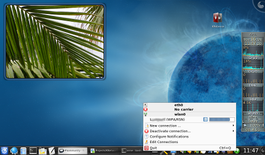KNetworkManager/it: Difference between revisions
(Created page with ''''KNetworkManager''' è un client KDE per il programma backend NetworkManager. '''KNetworkManager''' comunica con NetworkManager tramite DBus (un tipo di programma per passare m...') |
(Created page with 'Un utilizzo tipico è connettersi ad una rete wireless con credenziali note. L'utente imposterà una connessione e '''KNetworkManager''' memorizzerà le impostazioni ovunque le c...') |
||
| Line 8: | Line 8: | ||
'''KNetworkManager''' è un client KDE per il programma backend NetworkManager. '''KNetworkManager''' comunica con NetworkManager tramite DBus (un tipo di programma per passare messaggi). {{KDE3}} | '''KNetworkManager''' è un client KDE per il programma backend NetworkManager. '''KNetworkManager''' comunica con NetworkManager tramite DBus (un tipo di programma per passare messaggi). {{KDE3}} | ||
Un utilizzo tipico è connettersi ad una rete wireless con credenziali note. L'utente imposterà una connessione e '''KNetworkManager''' memorizzerà le impostazioni ovunque le configurazioni dell'utente vengano memorizzate. La configurazione includerà cose come il nome (''ESSID'') e la password utilizzata per aggiungersi ad una certa rete wireless. '''KNetworkManager''' può quindi utilizzare queste informazioni inserendole in una richiesta DBus per connettersi ad una particolare rete. Il backend Network Manager quindi compirà le operazioni di basso livello necessarie per impostare effettivamente i programmi di supporto (per esempio passando la ESSID e la chiave a '''wpa-supplicant''') e facendo andare il dispositivo di rete con le impostazioni appropriate. | |||
Along with the advantage of allowing normal users to control the configuration the network it also allows one consistent interface for network configuration on KDE, and other desktops (e.g. GNOME) can use the network manager back end without each having to implement the logic to handle network configuration. | Along with the advantage of allowing normal users to control the configuration the network it also allows one consistent interface for network configuration on KDE, and other desktops (e.g. GNOME) can use the network manager back end without each having to implement the logic to handle network configuration. | ||
Revision as of 14:05, 10 September 2010
Template:I18n/Language Navigation Bar
 |
Lascia che KNetworkManager gestisca le tue connessioni aperte e criptate. |
KNetworkManager è un client KDE per il programma backend NetworkManager. KNetworkManager comunica con NetworkManager tramite DBus (un tipo di programma per passare messaggi).
![]()
Un utilizzo tipico è connettersi ad una rete wireless con credenziali note. L'utente imposterà una connessione e KNetworkManager memorizzerà le impostazioni ovunque le configurazioni dell'utente vengano memorizzate. La configurazione includerà cose come il nome (ESSID) e la password utilizzata per aggiungersi ad una certa rete wireless. KNetworkManager può quindi utilizzare queste informazioni inserendole in una richiesta DBus per connettersi ad una particolare rete. Il backend Network Manager quindi compirà le operazioni di basso livello necessarie per impostare effettivamente i programmi di supporto (per esempio passando la ESSID e la chiave a wpa-supplicant) e facendo andare il dispositivo di rete con le impostazioni appropriate.
Along with the advantage of allowing normal users to control the configuration the network it also allows one consistent interface for network configuration on KDE, and other desktops (e.g. GNOME) can use the network manager back end without each having to implement the logic to handle network configuration.
- The Project Page gives an overview of features, some screenshots, and links to packages for several distros.
- More screenshots show its use on different desktop environments.
